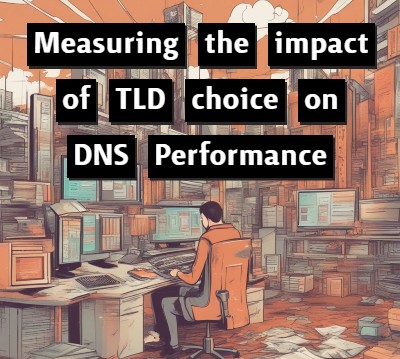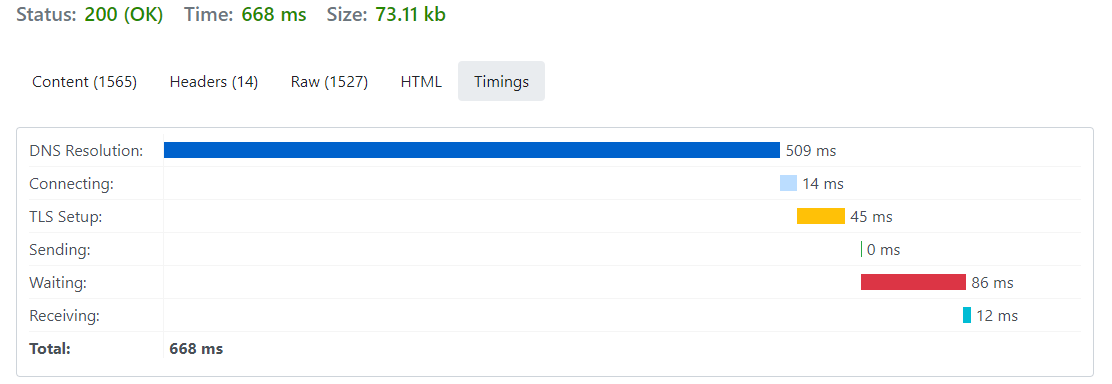Talk to our Experts
Our in-house experts have architected, designed, built and automated some of the UK's largest Enterprise Networks and Data Centres. We've probably:
- Networked it
- Designed it
- Automated it
Aug 07, 2023 devops Twitter GitHub info@caci.co.uk
Time was the Internet consisted of just a few Top Level Domains (TLDs) - .com, .net, .org and a few others - but not anymore. TLD-List reports there are now over 3,745 domain extensions and growing, with even some brands having their own Organisation Extensions such as .barclays and .bbc in use for Careers Sites, Product Pages and more.
As well as their obvious and well-documented impact on SEO, did you know they can also negatively impact your Website Performance - particularly on Load Times and TTFB?

We'll investigate how we replatformed some of our web assets to overcome an issue with SEO Performance we didn't even know we were having.
(Yes it's a pun, yes we're proud of that if you got it. Yes, we are hiring...)
DNS - or Domain Name System - is an often overlooked part of the Internet today, but is very much a key building block to the rest of the Web. Before we can discuss why differing TLDs have impact on performance, it is useful to have some grounding in DNS concepts first.
At its heart, DNS is a tree hierarchy - with an invisible dot as the mandatory root. At a base level, the main job of DNS is to resolve a domain such as www.google.com to an IPv4 or IPv6 Address such as 8.8.8.8 for TCP/IP to start the packet connection process to.
Let's explore this with the well-known subdomain calendar.google.com. Firstly, although you don't type this with the suffixed dot (.), it is very much there. Don't believe us? Try this in a Command Prompt:
ping calendar.google.com.
Here's what we get:
ping calendar.google.com.
Pinging calendar.google.com [142.250.180.14] with 32 bytes of data:
Reply from 142.250.180.14: bytes=32 time=7ms TTL=119
Ping statistics for 142.250.180.14:
Packets: Sent = 1, Received = 1, Lost = 0 (0% loss),
Approximate round trip times in milli-seconds:
Minimum = 7ms, Maximum = 7ms, Average = 7ms
ProTip: Ever tried to
pingornslookupsomething external likewebsite.comonly to have the result come back aswebsite.com.internal.corp.acmeco.localon you? Same difference; Windows commands likenslookupassume everything is a subdomain of your DNS Suffix Search List if you don't suffix a "." (dot) at the end. Most Applications like Web Browsers automagically do this in the background for you; much the same as they silently add:443to the end of HTTPS websites
If we deconstruct calendar.google.com, and process it right-to-left from the perspective of the DNS Tree Hierarchy, it's made up of:
. (invisibly added in)comgooglecalendarThe hierarchy is important because each layer informs which signpost needs to be used for the IP Address Lookup up the tree. Name Servers (or "NS") are used to act as the signpost for Domain Name to IP Address resolution. There are two main "types" of Name Server (DNS Purists will come for us - we know, we know...):
This distinction is important when it comes to the level of detail signposted by a given Name Server at any given level of the DNS Hierarchy.
The level of a Name Server within the hierarchy determines the amount of information it returns, and normally the higher the level (towards the root), the less information it gives (is just likely to signpost to another Name Server with the detailed IP information). Using the same example, let's see this in practice with the same calendar.google.com example and walk-through the hierarchy:
| Element | Level | Response | Notes |
|---|---|---|---|
. (dot) |
Root | com is served by a.gtld-servers.net |
Notional "response" to show concept |
google.com |
TLD | Google.com is served by Name Server ns1.google.com |
This is the response that (via the DNS Resolution Chain) a.gtld-servers.net gave |
calendar.google.com |
Subdomain | calendar.google.com is available at 142.250.187.238 |
This is the response that ns1.google.com gave |
As can be seen, the function of each upper-level of the hierarchy is ultimately to point to another signpost element lower-down in the hierarchy that knows the IP Address answer. The reason for this is scaling - it wouldn't scale to have a flat hierarchy of all the 628.5 million registered Domain Names in the Web, let alone the numerous hundreds or thousands of subdomains each of those could have.
In practice the Client rarely probes the actual Authoritative DNS Resolver for a given DNS Zone, usually the DNS Recursion Chain is such that a Client resolves against a Caching DNS Server run by their downstream ISP, CDN, Cloud or other DNS Provider. Here caching plays a role to offload lookup stress on the DNS Ecosystem; the above example is simplified to show the concept in isolation of the impact of DNS optimisations such as DNS Caching and Anycast
You may have been around the Interwebs long enough to have heard of the infamous "13" Root Servers which effectively act as the Name Server phonebook for the original TLDs such as .com and .net, and are currently:
| Name Server | IPv4 Address | IPv6 Address |
|---|---|---|
| a.gtld-servers.net | 192.5.6.30 | 2001:503:a83e:0:0:0:2:30 |
| b.gtld-servers.net | 192.33.14.30 | 2001:503:231d:0:0:0:2:30 |
| c.gtld-servers.net | 192.26.92.30 | 2001:503:83eb:0:0:0:0:30 |
| d.gtld-servers.net | 192.31.80.30 | 2001:500:856e:0:0:0:0:30 |
| e.gtld-servers.net | 192.12.94.30 | 2001:502:1ca1:0:0:0:0:30 |
| f.gtld-servers.net | 192.35.51.30 | 2001:503:d414:0:0:0:0:30 |
| g.gtld-servers.net | 192.42.93.30 | 2001:503:eea3:0:0:0:0:30 |
| h.gtld-servers.net | 192.54.112.30 | 2001:502:8cc:0:0:0:0:30 |
| i.gtld-servers.net | 192.43.172.30 | 2001:503:39c1:0:0:0:0:30 |
| j.gtld-servers.net | 192.48.79.30 | 2001:502:7094:0:0:0:0:30 |
| k.gtld-servers.net | 192.52.178.30 | 2001:503:d2d:0:0:0:0:30 |
| l.gtld-servers.net | 192.41.162.30 | 2001:500:d937:0:0:0:0:30 |
| m.gtld-servers.net | 192.55.83.30 | 2001:501:b1f9:0:0:0:0:30 |
As it turns out, these aren't the only Root Name Servers in town; there are an ever-increasing set of Root Servers to support the ever-increasing amount of TLDs proliferating today, as recorded by the IANA Root Zone Database.
What's more, these aren't all created equal - as it turns out, not everyone is as passionate about DNS Performance optimisation as internet society organisations such as the IETF are.

Please, take a seat - it shocked us too. We were looking into why the response time of some parts of our previous Job Board cacins.careers were so bad, and had just moved from using cURL commands into the awesome ReqBin REST Testing Tool when we spotted the above. Assuming no DNS Caching in play, of the 668ms response time, DNS resolution took up a shocking 509ms - or 76% - of the entire HTTP GET process.
"Surely it's just us, surely other domains aren't affected as well?"
"It can't... you can't... five-HUNDRED-milliseconds?"
"You're making these quotes up just to make the Blog sound more plausible? I can't believe you'd do such a thing!"
So the journey began. Using the IANA Root Zone Database, we undertook the following not-really-that-scientific process to check if it was indeed just us:
powershell "Measure-Command { nslookup domain.tld. root.tld.server.tld. }"
fast.com this command was: powershell "Measure-Command { nslookup fast.com. a.gtld-servers.net. }"Here's our quasi-scientific results:
| TLD | Domain | First Root DNS Server | TLD Manager | Lookup Time |
|---|---|---|---|---|
| ai | fast.ai |
a.lactld.org |
Government of Anguilla | 92ms |
| app | fast.app |
ns-tld1.charlestonroadregistry.com |
Charleston Road Registry Inc | 88ms |
| blog | fast.blog |
a.nic.blog |
Knock Knock WHOIS There LLC | 116ms |
| careers | fast.careers |
v0n0.nic.careers |
Binky Moon LLC | 496ms |
| com | fast.com |
a.gtld-servers.net |
VeriSign Global Registry Services | 58ms |
| co.uk | fast.co.uk |
dns1.nic.uk |
Nominet UK | 102ms |
| io | fast.io |
a0.nic.io |
Internet Computer Bureau Limited | 62ms |
| net | fast.net |
a.gtld-servers.net |
VeriSign Global Registry Services | 48ms |
| network | fast.network |
v0n0.nic.network |
Binky Moon LLC | 482ms |
| org | fast.org |
a0.org.afilias-nst.info |
Public Internet Registry (PIR) | 458ms |
| tech | fast.tech |
a.nic.tech |
Radix FZC | 95ms |
| training | fast.training |
v0n0.nic.training |
Binky Moon LLC | 488ms |
We only picked the
fastdomain because we thought it would be most-likely to be registered across a selection of some technology-related TLDs and not give a false-positive with a NXDOMAIN response. Also maybe we want you to think we're really, really fast at doing things
Clearly this isn't taking into the account the following:
But does give some food for thought on the impact that a seemingly invisible part of every Web App request - the DNS Lookup - can have, and how such a low-level component such as choice of TLD can impact this. Turns out it's not just SEO that can be impacted by TLD choice.
Our in-house experts have architected, designed, built and automated some of the UK's largest Enterprise Networks and Data Centres. We've probably:
At CACI Network Services we're well practiced in going full-blown Poirot on a variety of DNS, Network and Cloud murder mystery investigations. We've completed so many we think we're in for a shot with being the guest stars on the next Midsomer Murders.
In the meantime, if you'd like us to keep go all Pink Panther on your very own Infrastructure Conundrum, we're all (pink) ears - get in touch and let us help you go from Inspector Clouseau to clue-solved.
And whatever you do, don't start humming the Pink Panther theme tune in your head, you'll never get it out... Sorry. No really. Sorry.